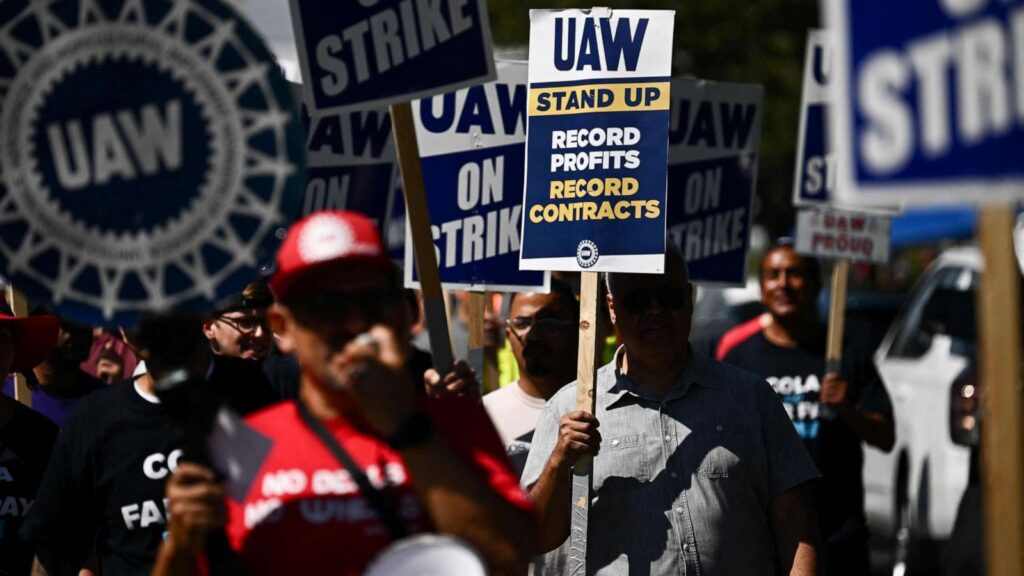The Year in Unions

I was one of the people interviewed for this ABC piece on the rise in strikes this year.
Greg Iwinski, a late-night TV writer, walked off the job this year amid a dramatic surge of workers going out on strike — and he says the trend made its presence felt at the bargaining table.
“The ammunition that a company has, whether it’s an automaker or a TV studio, is telling you that a strike won’t work — your collective action won’t help,” Iwinski, who helped broker an agreement that delivered significant pay increases for 11,000 Hollywood writers, told ABC News.
A slew of contract breakthroughs over the course of 2023 dispelled that notion, Iwinski said. “If you hold out long enough, you will break them and win,” he said.
The Alliance of Motion Picture and Television Producers, or AMPTP, which negotiated on behalf of the TV studios, did not immediately respond to ABC News’ request for comment.
Iwinski was among more than 500,000 workers who went out on strike nationwide in 2023, nearly tripling the figure recorded over the same period a year earlier, according to data through the end of October from Cornell University’s School of Industrial and Labor Relations shared with ABC News.
The sharp escalation in worker protests arose from widespread dissatisfaction with sluggish wage gains, which in many cases had failed to keep up with rapid price hikes, experts told ABC News.
Emboldened by a tight job market and growing approval of unions, workers took a step that often frightens employees concerned about losing their livelihoods, they added.
“This is a demonstration of the anger that American workers have about their position in the economy,” Erik Loomis, a labor professor at the University of Rhode Island and author of “A History of America in 10 Strikes,” told ABC News.
“We’re in an era where people are seeing the strike as a tool once again,” Loomis added, noting that the number of workers on strike this year was last seen in the early 1980s.
Labor militancy will continue in 2024 since worker disaffection remains, experts added, though the potential for fewer contract disputes at large unions could result in a decline in the number of workers walking off the job.
The actual number of strikes this year is flat. But there were huge unions striking. So total numbers of workers on strike this year skyrocketed. We will see if that latter number can maintain next year. I can’t think of any potential strikes like the UAW against the automakers such as we saw this year. Though I may be forgetting something. In any case, I wouldn’t expect strikes to go away. I often get asked about this and the reality is that until the underlying economic conditions change, i.e., income inequality declines, we are quite likely to see continued strike waves. Forget what the economists say–the most important measurement of the economy for our lives and even more importantly for our lives is the lived experience of the economy. If people don’t feel the economy is working for them, they are going to act upon that. Going back to the 2008 housing crisis, people really don’t feel this. If you went back to that time and said that class consciousness was going to be a major part of our politics again 15 years later, however wobbly it might be, it would have surprised many people at the time.
Another way to put this is that when I went into labor history in graduate school–this was the early 2000s–some of my professors thought I’d never get a job in it. After all, this was the age where the hip scholars were all in on the history of capitalism, as if labor historians hadn’t been studying capitalism for decades (though I do grant that those scholars did advance our understanding significantly, especially for pre-Civil War America). Today, nobody gets jobs at all since higher education has decided to become a training school for whatever whims capitalist donors have in a given year. But my career has only been helped by realizing that the upper middle class people who make up academia didn’t have any clue how the economy was horrible for working people. Today, there’s so much more awareness of that and here I am ready to contribute to that conversation.


